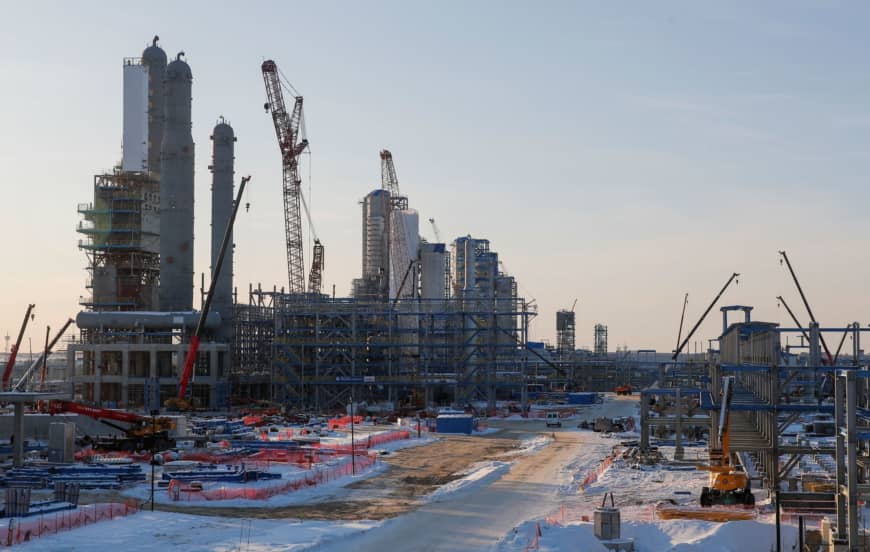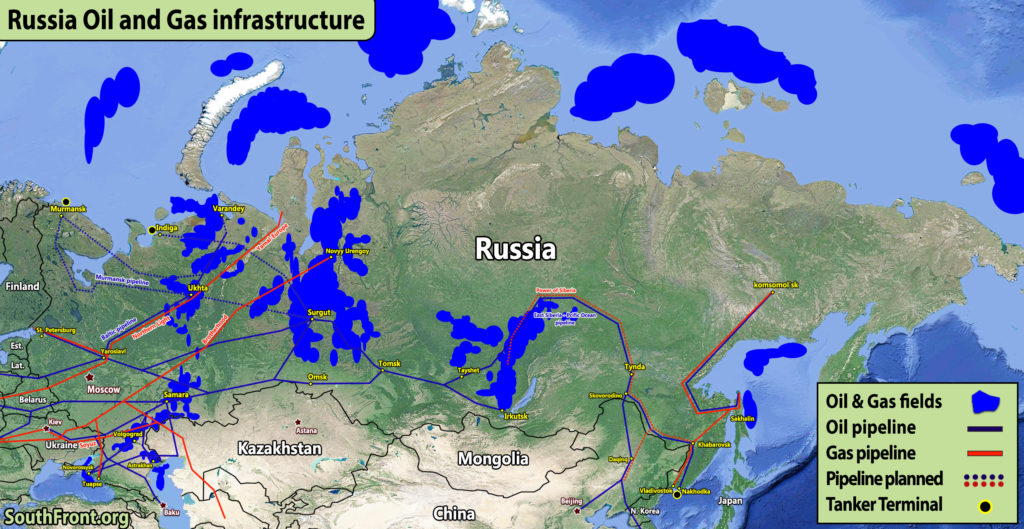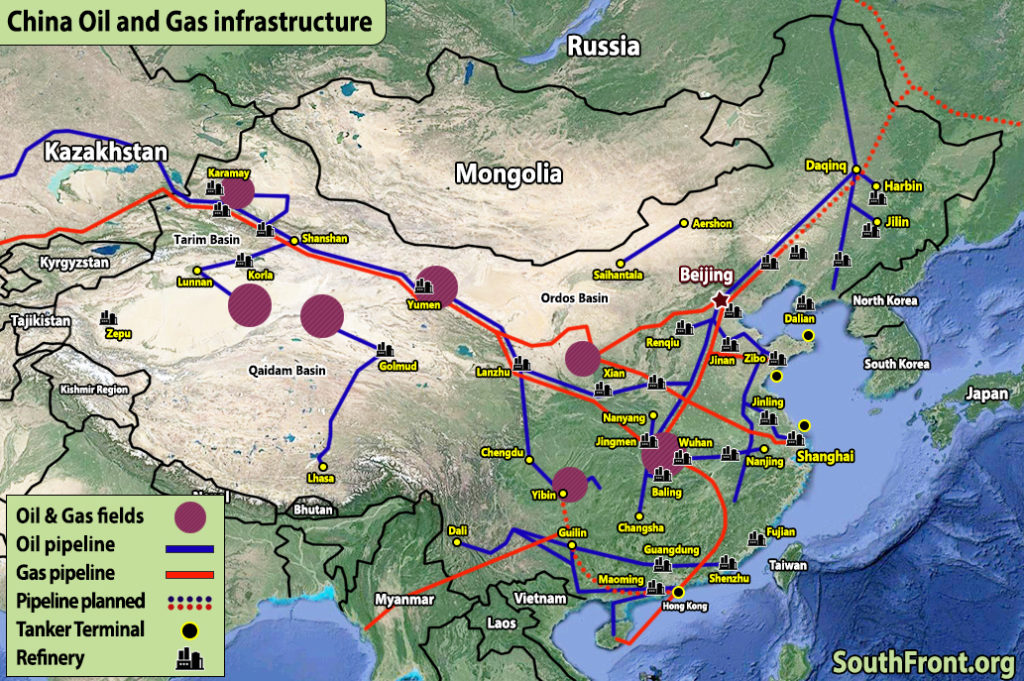SouthFront is a crowdfunded endeavor that operates thanks to the audience’s support. If you like what we do, please, support our current work and further existence of SouthFront: PayPal: southfront@list.ru, http://southfront.org/donate/ or via: https://www.patreon.com/southfront
***

A general view of the construction site of Amur gas processing plant, part of Gazprom’s Power Of Siberia project outside the far eastern town of Svobodny, in Amur region, Russia November 29, 2019. Picture taken November 29, 2019. REUTERS/Maxim Shemetov. Click to see full-size image
On December 2nd, Russian President Vladimir Putin and Chinese President Xi Jinping launched the “Power of Sibera” gas pipeline. The deal for the delivery of Russian gas to China is a 30-year-long contract, worth $400 billion. It was signed in 2014 after long negotiations.
It is Gazprom’s biggest contract and the company is to supply China with 38 billion cubic meters of gas annually when the pipeline is fully operational in 2025.
Gazprom stressed that the pipeline runs through “swampy, mountainous, seismically active, permafrost and rocky areas with extreme environmental conditions.”
Regarding the project, Chinese Vice Foreign Minister Le Yucheng said the pipeline will boost cooperation and allow the two countries “to complement each other’s strengths and pursue common rejuvenation.”
The Power of Sibera pipeline will allow Russia to cover between 10 and 15% of the Chinese gas market. Before reaching the end goal of 38 billion cubic meters of gas per year in 2025, Gazprom will deliver 5, 10 and 15 billion cubic meters in the next 3 years.
In addition to the massive gas project, trade turnover between China and Russia is also constantly increasing, with expectations that it would grow to $200 billion by 2024.
“By 2024 we will reach trade turnover of $200 billion. I think this goal is achievable because from now on trade and economic cooperation is rapidly developing,” Zhang Hanhui, China’s ambassador to Moscow said.
In 2017, it surged by 20.8% year-on-year to US$84.07 billion, when China-Russia bilateral trade was the world’s fastest growing trade corridor. The turnover for 2018 stood at $108 billion, with an increase of about 5% between January and August 2019. Estimates show that by the end of 2019 turnover would be upwards of $110 billion, a roughly 10% increase.
Due to the trade war between the US and China, Beijing is looking for a reliable new partner for many commodities, and specifically agricultural products, which Russia could deliver.
Russia and China are also expanding cooperation in the military field, with Moscow helping China become the third country in the world to employ a comprehensive missile defense system, which currently only Moscow and Washington operate.
China also recently received its S-400 missile defense systems from Russia. It also received two batches of Su-35 fighter jets, one batch of 4 in 2016 and one batch of 10 in 2017. The final 10 are to be delivered soon, and Russia will reportedly offer the sale of more of the fighter jets to Beijing.
These examples of improving economic relations between Russia and China, are a part of the wider trend of the growing economic cooperation between Asia and Europe.
Since 2000 trade between Europe and Asia has been rapidly growing. China in 2012 concluded an agreement in Warsaw with 16 countries of Central and Eastern Europe based on trade and investment cooperation. As a result of the implementation of this agreement, the volume of mutual trade increased significantly: in 2010 it amounted to $43.9 billion, in 2017 had increased to $67.98 billion.
According to Eurostat, in 2017, the foreign trade turnover between Europe and China amounted to $631 billion, while China-US trade stood at $695 billion.
At the end of March 2019, Chinese President Xi Jinping toured a number of European Union countries, as a result of which contracts were signed in France for $44 billion, and in Italy – for $2.8 billion.
In connection with the conclusion of new contracts with France, Beijing will gain access not only to its high-tech industry, but also to Mediterranean ports.
China would also be allowed to invest in the Italian ports of Trieste, Genoa and Palermo. Trieste has a special customs regime, and it has direct rail links with other European countries. Bilateral cooperation with the participation of Italian State Railways is also expected.
At the International Arctic Forum, held in St. Petersburg on Between April 9th and 10th, the Russian Ministry of Eastern Development and Rosatom presented their vision of an updated economic model for the development of the Northern Sea Route (NSR). According to Alexander Krutikov, Deputy Minister of the Ministry for the Development of the Russian Far East, in the next 10 years, the NSR will be used to export Russian hydrocarbons from the Arctic. This will ensure the development of infrastructure, the creation of an icebreaker group, and year-round use of the NSR.
This route would also allow quicker access for Chinese freight to Northern Europe.
Further growth in freight turnover is planned due to the supply of liquefied natural gas from the already existing Yamal-LNG plant and from the planned Arctic LNG-2.
Tokyo is also working on the safety of navigation in northern waters and plans to create its own navigation support system in the Arctic Ocean with an eye on the NSR. By the end of 2020, Japan will build a new icebreaker with special radars to monitor the water surface and measure the thickness of the ice.
Based on such data and information from satellites, the most optimal and safe route for merchant ships will be developed. The decision to build a new icebreaker was made after Novatek announced the sale of a 10% stake in the Arctic LNG-2 natural gas liquefaction plant to a consortium of Japanese Mitsui & Co and Jogmec.
China is furthermore actively working on its Belt and Road Initiative, which recently received praise from Russian President Vladimir Putin and there are promises of grand support for the projects. It’s gaining more and more popularity bought in Asia, as well as from some countries in Europe wishing to take part in it.
Another potential improvement in economic cooperation between Asia and Europe could be the tunnel between Helsinki and Tallinn. The project is at the design stage since the 2000s. In 2008, Tallinn and Helsinki signed a letter of intent. As of December last year, there were two tunnel construction projects: FinEst Bay Area (one of the project managers Peter Westerbackka, former development director of Rovio and one of the creators of the game Angry Birds) was behind one, and Finnish authorities represented by the company FinEstLink.
The latter have already submitted an application to the Estonian authorities for construction work, and FinEst Bay Area presented in March 2019, a document on transboundary environmental impact, almost simultaneously signing an agreement of intent on financing in the amount of 15 billion euros with the Chinese fund Touchstone Capital Partners, which will receive a minority stake, and the majority stake will remain in Finland.
Finnish, Swedish and Estonian experts who have studied the possibilities of implementing the project have come to the conclusion that the underwater tunnel will pay off if it passes through the Baltic Rail European Rail Track, which crosses the Baltic countries.
The project cost is estimated at about $6.3 billion, of which 85% should be provided by the European Union. For comparison, Germany in the next 10 years plans to invest $86 billion in the development of its railways.
Russia recently launched the world’s first floating nuclear power plant – the Akademik Lomonosov, which arrived in Chukotka on September 14th, 2019. The 140-meter floating plant, which was more than a decade in the making, is equipped with two KLT-40 reactors that provide a combined 70 megawatts of power.
The US, China, as well as France are reportedly working on similar technology, and Russia is reportedly planning to build more such ships that can travel to various points in the world and provide basic commodities such as electricity and purified water. These floating nuclear power plants would also make it easier to build various infrastructure along the Northern Sea Route.
Russia and China are becoming a center of a new economic cluster that will be among the key factors shaping the economic landscape of Eurasia in the coming years. At the same time, European states with strong industry are in need of cheap energy resources and skilled workers to boost their economy. Often, they seek to obtain them in Russia and China.
The US, through its own efforts and those of its European proxies are fiercely attempting to antagonize EU’s cooperation with Moscow and Beijing. These includes states that, mostly due to surrendering their de facto sovereignty have sold their industrial and human potential to Washington and are left with the only choice of supporting every whim the US has, such as withdrawing from the INF.
Washington itself is employing great effort to impede Russia and China’s prospects for economic cooperation in Europe. A very obvious and still actual example is the US’ opposition of the Nord Stream 2, going as far as even threatening of sanctions if it goes online. It is, however, showing that the lack of any incentive provided by the US if the project is stopped, apart from expensive liquefied natural gas, that can only be delivered to terminals that are convenient for Washington.
The Nord Stream 2, the Turk Stream and other projects with Russian and Chinese involvement in Europe appear to be going full steam, as the US appears to be losing its ability to enforce its will on the foreign playing field.
MORE ON THE TOPIC:








the envious collapsing US empire is near collapse–it cannot compete
Only primitives in their own primitive economies can see that. They never operate with making the cake to share bigger.
Those ideas seemes to be a good idea, but parts of the base is completly wrong. We see it in the article as well. ¨Focus is in oil, gas and weapons only.
If the climate change will continue there will be bigger and bigger lack in the already water lacking deserts and steppes.
So many many millions soon will need a lot of food. So what about solving that dry future by better food making. Maps shows it well.
There are many plans for fossile energy transportation. Thats another aspect. Not only USA is against this and that in those matters. It a fight.
But there are at least partly solutions for that lack of energy. So far electricity by wind and solar cells seemes to be good alternatives. Those are very good local ones.
As its written in their version of the Choran the Chones already has a great lack og energy but also plan more smog for themselves then now by ned coalmines. I do blame them very much.
Already in COOP 2012 in Copenhagen I rememer China would not close old powerplants driven by dirty coal BUT would try to make all needed new investments in that sector polluting less. We dont see that.
Great areas of Chna now has extra expensies, where people die young and suffer by bronchities and astma. So I hope they invest in more hospitals or and dont invest roo much in burning even more fuel.
If I need a smile, I see Russians in their Daccas fishing in the dark along their part of the arctic coast,.